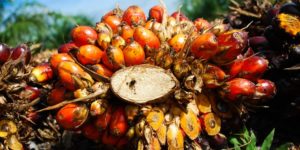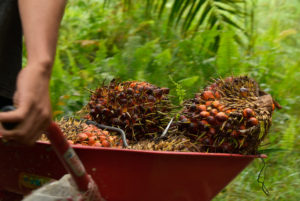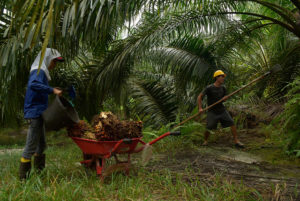
Palm oil: people love it, hate it or maybe just use it without even knowing. The controversial vegetable oil is found in thousands of consumer products from soap to lipstick, frozen pizza, ice cream and even fuel.
World demand continues to increase rapidly and is placing pressure on forests, mainly in Indonesia. But, for now, the profitable commodity is here to stay. So what can be done to reduce the pressure on forests?
Efforts are ongoing to stop the rapid destruction of tropical forests through more sustainable business practices. In 2004, the Roundtable on Sustainable Palm Oil (RSPO) was launched with the vision to “transform markets to make sustainable oil palm the norm”. Pressure from activists on big corporations that use palm oil in their products has also had some impact, leading them to make commitments to sustainable supply and zero deforestation.
Most action to date has focused on how large palm oil companies do business but increasingly, concerns comprise what the implications are for smallholders, and how smallholders can capture greater benefits from engaging in palm oil supply chains.
In Indonesia — one of the biggest palm oil producing countries alongside Malaysia — up to 40 percent of the land used to grow oil palm is cultivated by smallholders who farm, on average, just 2 hectares each.
The sustainability of the palm oil sector has also triggered Indonesian government efforts to improve the policy environment for inclusion of smallholders, and channeling resources for them to improve practices in management and replanting. There is also an ongoing effort to strengthening the national standards for sustainable palm oil (ISPO).
Read more: Towards responsible and inclusive financing of the palm oil sector
Three teams of researchers from the Center for International Forestry Research (CIFOR) as part of its work under the CGIAR Research Program on Forests, Trees and Agroforestry (FTA) and from partner institutions have produced a series of infobriefs looking at how smallholders can improve their lives and, at the same time, protect remaining forests. The major challenge, according to their findings? Money.
“Oil palm provides more economic benefits to smallholders than other crops, and it’s expanding,” says Pablo Pacheco, a Principal Scientist at CIFOR. “Yet smallholders have to adopt more sustainable practices. Research has to contribute to this, and identify options for them to improve their practices, as well as identify what resources are needed to make that change happen.”
“That’s where financing comes in, and becomes an important key resource for smallholders to be able to access,” he adds.
THE REPLANTING CHALLENGE

The Indonesian government estimates that a total of 175,000 hectares of oil palm farmed by smallholders needs to be replanted each year, and this alone creates major challenges for farmers.
Hans Harmen Smit, global coordinator for palm oil at the Netherlands Development Organization (SNV), one of the partner organizations, was part of the team that examined current finance practices. Their focus was on Indonesia and Malaysia, which together account for about 85 percent of total global palm oil production. Smit says that without proper financing, farmers only replant when they can afford to.
“The problem is, once they replant, they have to wait three years at least for the new plantation to become productive, and during that time they have no income,” he says.
Smallholder income from oil palm varies. On average, smallholders with around two hectares of land can earn a gross monthly income of US$290 to US$400.
Researchers say that without financial support, farmers do not have the resources to replant year after year on the same plot, and so they tend to move to peatlands and forested areas, “slash and burn” the land, and plant the only crops available to them, which are often low-quality varieties.
Smit points out that in Malaysia, the sector has better systems in place for replanting, and smallholders can more easily obtain financial support. In Indonesia, there is the Crude Palm Oil (CPO) Fund that supplies replanting loans, but it is often difficult to access, especially for smallholder farmers with limited funding.
“The lesson learned here is that saving for replanting is often not done as it should be. The government needs to engage more and manage programs to help farmers save for replanting,” says Smit.
He adds that one of the main problems is a lack of available information for financial service providers (FSPs) to evaluate the lending risks and set appropriate interest rates. He says the loans are often too small on an individual level, and this makes the loan origination costs too high compared to their value.
“We need to start by supporting better data collection on the cash flows of smallholders. Once this data is available, we can create investible portfolios for investors,” says Smit.
Read more: The long and winding road to sustainable palm oil
FUNDING THE GAPS

The researchers also identified major gaps between existing credit schemes and what farmers actually need. Addressing this could pave the way for more sustainable palm oil for smallholders.
One key finding was that lenders who do offer credit only provide it in the short term. But what smallholders actually need is both working capital and credit in the long term for replanting and financing other management practices.
“Most lenders also don’t have schemes that take into account the fact that oil palm farmers don’t make any money in the first three or four years, so they can’t make payments at this time unless they find additional sources of income, which is difficult,” says Pacheco.
Another issue is repayment of loans. When ‘tied’ farmers, who are under contract with oil palm plantations, access funds through a cooperative, profits from their harvest are used to pay back their loans. But when individual farmers seek loans, they have to pay back in cash.
Smallholders trying to access loans also face major challenges when trying to meet the requirements of most FSPs.
“Sometimes they don’t have savings accounts or own the land, so they can’t provide collateral,” says Pacheco.
Pricing of the fresh fruit bunches (FFB) produced by oil palm can also be a challenge for farmers. FFB prices are set by governments and oil palm companies, and tied farmers are paid more than independent farmers.
But there are ways to help smallholders overcome these challenges. Incentives and technical support to meet sustainability requirements, land tenure security, and support for FSPs to assess and manage risks, and build the capacity of smallholder organizations, could all have an impact, the research finds.
FINDING SUSTAINABLE FINANCE
Most of the financing for major palm oil companies comes from FSPs based in Asian countries like Japan, Malaysia, Indonesia and Singapore. And on the whole, these do not employ adequate environmental, social and governance (ESG) policies, the research suggests.
“American- and European-based FSPs’ policies are more advanced, but even they don’t fully address how financial resources can be better channeled to smallholders,” says Pacheco.
He warns that there is the danger of a two-tier marketplace developing: one in Asia, where there is less consumer pressure for sustainable palm oil, and a second focusing on US and European markets that have adopted more sustainable practices.
INVESTING IN PEOPLE
Pacheco says the future of smallholders holds a real dilemma. If they become more integrated into the existing supply chain, more productive, use better practices and have access to good financing and markets, they are likely to become more and more dependent on supply chains and companies for their livelihoods.
“You want smallholders to improve system practices, their knowledge of fertilizers, harvesting and so on, but without losing their freedom,” says Pacheco.
It all comes down to how farmers are empowered to negotiate prices, conditions with companies and so on, he adds.
“For me, social empowerment is critical, and I think that needs to be included in the debate. Up to now, the focus has been on efficiency, sustainability, less impact on forests — and not enough attention has been given to empowering these important players, the smallholders, who are trying to reap as much benefit as possible in the market,” he concludes.
By Suzanna Dayne, originally published at CIFOR’s Forest News.
For more information on this topic, please contact Pablo Pacheco at p.pacheco@cgiar.org.
This research was conducted by CIFOR in partnership with Profundo, the International Center for Applied Finance and Economics (InterCafe) at the Bogor Agricultural University (IPB), the Netherlands Development Organization (SNV) and Financial Access (FA).
This research forms part of the CGIAR Research Program on Forests, Trees and Agroforestry, which is supported by CGIAR Fund Donors.
This research was supported by the United States Agency for International Development (USAID) through the project “The Role of Finance in Integrating Oil Palm Smallholders into Sustainable Supply Chains.”











